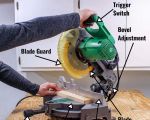How to Use a Laser Level for Precise Measurements
If you're looking to achieve perfect alignment or ensure precise measurements for your next project, a laser level is an essential tool. Whether you’re hanging pictures, installing shelves, or setting up equipment, the laser level provides a straight and accurate line, making tasks easier and more efficient. Here’s a guide on how to use a laser level effectively for precise measurements.
1. Understanding the Basics of a Laser Level
Before diving into how to use the tool, it's important to understand the basic components of a laser level. A laser level projects a beam of light that serves as a reference for horizontal or vertical alignment. There are various types of laser levels available, including:
- Line Laser Level: Projects a straight line, often used for tasks like hanging pictures or aligning tiles.
- Rotary Laser Level: Spins to create a rotating laser beam, used for larger spaces and tasks like grading and leveling foundations.
- Dot Laser Level: Projects one or more dots for small-scale alignment work, often used for leveling equipment.
Once you’ve selected the appropriate laser level for your project, it’s time to get started with the setup and usage process.
2. Setting Up Your Laser Level
To ensure accurate measurements, setting up the laser level properly is crucial. Here’s how to do it:
- Choose a Stable Surface: Place the laser level on a stable surface or tripod. If using a tripod, ensure it’s securely locked in place to prevent any movement.
- Positioning the Level: Position the laser level at the desired height for your project. For example, if you’re aligning a row of pictures, position the level at the height where you want the top of the pictures to be.
- Turn the Laser Level On: Once the level is set, power it on. You should see the laser line projected onto the surface or across the area you’re working in.
- Ensure the Level is Calibrated: Some models come with an automatic calibration feature, but others may require manual adjustment. Make sure the laser line is level before proceeding.
3. Using the Laser Level for Precise Measurements
Now that your laser level is set up, it’s time to use it for measuring and aligning. Here are the steps to follow:
- Align the Laser Line: Position the laser line on the surface where you need the measurement. For instance, if you're aligning tiles, use the laser line as a guide to ensure they are straight.
- Marking Reference Points: As the laser projects a straight line, use a pencil or chalk to mark reference points along the beam. This helps in measuring distances between objects or surfaces.
- Use for Vertical and Horizontal Alignments: Laser levels can also be used to check for vertical and horizontal alignments. Whether you're setting up a row of cabinets or checking the alignment of a wall, simply adjust the level to project vertically or horizontally and make your measurements accordingly.
- Double-Check for Accuracy: After marking, measure the distance between the marks to ensure accuracy. You can use a tape measure or ruler to confirm that the markings are consistent.
4. Common Applications of Laser Levels
Laser levels are used in various applications. Some of the most common scenarios where these tools come in handy include:
- Home Renovations: Whether you're installing shelves, mounting a television, or aligning frames on the wall, laser levels make these tasks easier and more precise.
- Construction: Laser levels help professionals ensure that everything from walls to foundations are level, improving the overall quality of the build.
- Landscaping: When leveling soil or grading for landscaping projects, a rotary laser level can ensure proper alignment across large areas.
- Tile Installation: Whether for flooring or backsplashes, laser levels assist with keeping tile lines straight and even, ensuring a polished look.
5. Benefits of Using a Laser Level for Precision
The laser level is an essential tool for anyone requiring precise measurements. Some of the key benefits include:
- Improved Accuracy: Laser levels help eliminate human error and provide a straight, clear line of reference, ensuring that measurements are accurate.
- Time-Saving: These tools speed up tasks that would typically require multiple steps or tools, like measuring and aligning manually.
- Versatility: With multiple settings (horizontal, vertical, or rotating), laser levels are versatile and can be used for various projects, from small home improvements to large construction work.
- Ease of Use: Most laser levels are designed to be user-friendly, with easy-to-understand instructions, making them suitable for both professionals and DIY enthusiasts.
When used correctly, a laser level can become an indispensable tool in your collection. Whether you're a seasoned builder or a DIY enthusiast, using a laser level will help ensure that your measurements are accurate and your projects are completed efficiently. If you're in need of the best laser levels for your work, check out ToolNest for a wide selection of high-quality tools that will help you achieve precision in every project.









